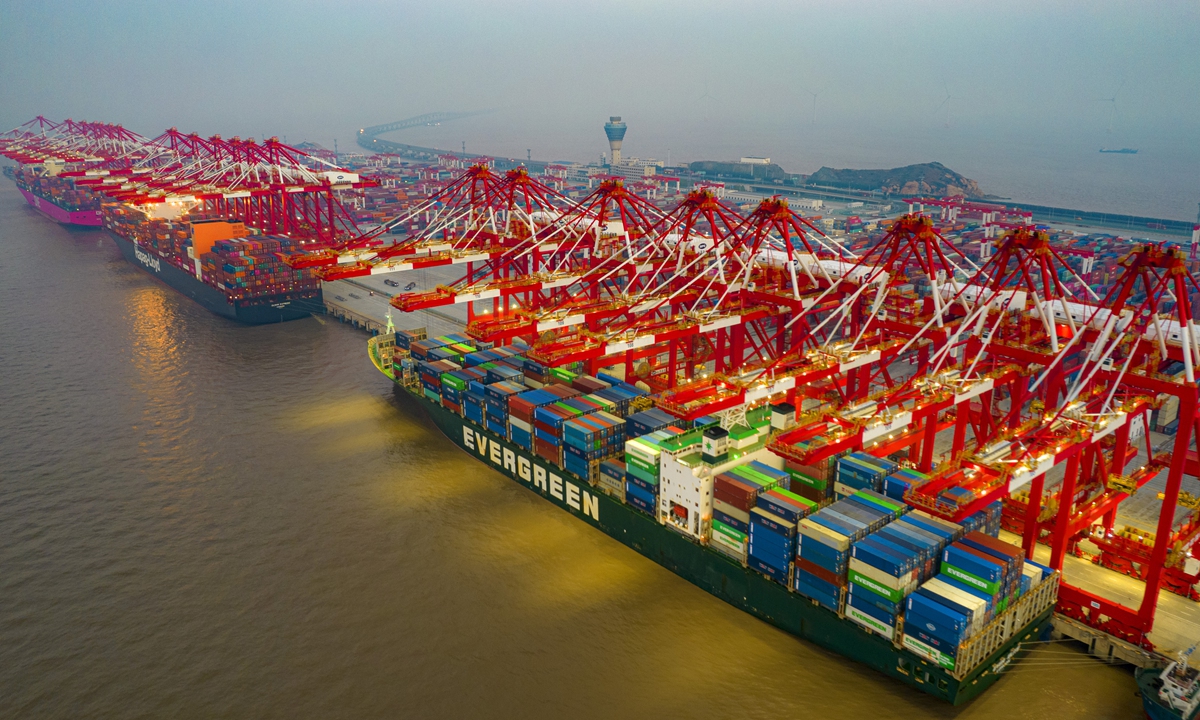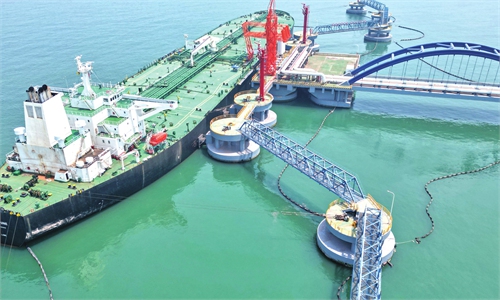China H1 trade posts resilient growth of 9.4% as economy bounces from Omicron shock
Booming demand at home and abroad pushes domestic GDP closer to set target, observers say

Container vessels berth at the Port of Yangshan to clear cargo around the clock in Shanghai on January 2, 2022. In 2021, the Port of Shanghai handled over 47 million standard containers, ranking first among the world's ports for the 12th consecutive year. Photo: VCG
China's trade sector is picking up speed toward mid-year with unexpected force, as the country's total imports and exports expanded by an above-expected 9.4 percent in the first half of this year, driving the world second largest economy to dash toward its set economic target in a year of challenges, data released by China's General Administration of Customs (GAC) showed on Wednesday.
The nation's robust trade growth in the first six months of 2022, particularly highlighted by accelerating imports and exports in the COVID-19 afflicted Yangtze River Delta in June not only underlines a steady overall economic rebound amid the government's policy package to stabilize the COVID-hit economy, but also reflects the irreplaceable appeal of Chinese goods to overseas countries suffering through soaring inflation, experts said.
According to customs data, China's trade grew by 14.3 percent year-on-year to 3.7 trillion yuan ($550 billion) in June, compared with 9.6 percent growth in May.
Accumulatively, the country's total imports and exports grew 9.4 percent on a yearly basis to 19.8 trillion yuan in the first six months this year, outpacing the 8.3 percent growth in the January-May period. Exports surged 13.2 percent over the period, beating analysts' forecast of 12 percent. Imports grew 4.8 percent.
One highlight of China's trade situation in H1 is the rapid recovery of exports and imports in the Yangtze River Delta after a severe recent outbreak of COVID-19 infections.
According to data detailed by GAC spokesperson Li Kuiwen on Wednesday, total imports and exports for East China's Jiangsu, Zhejiang, Anhui provinces and Shanghai in the Yangtze River Delta were 7.14 trillion yuan in the first half of this year, a year-on-year increase of 9.3 percent. Among them, the region's foreign trade in June was 1.39 trillion yuan, a year-on-year increase of 14.9 percent, which contributed nearly 40 percent to the national foreign trade growth, Li noted.
According to Li, China's trade sector has displayed relatively strong resilience in the first half of this year. "The first quarter had a stable start, May and June quickly reversed the falling trend, which laid a solid foundation for the trade sector's stability and quality improvement throughout the year," Li said.
Industrial chain advantage
Experts and business leaders cited several reasons behind China's recent trade boom, and one direct reason is the fall of sea freight costs that has driven up demand.
A Shenzhen-based air conditioner exporter told the Global Times that more overseas orders arrived after shipping rates dropped sharply from mid-June. "Shipping freight costs for export orders are borne by overseas customers in most cases. High sea rates have prevented foreign customers from making orders. Now, export businesses began to recover."
The cost from China to the US West Coast fell to $7,000 per standard container at the end of June from around $13,000 in early February, ending a ten-month run of $10,000, one Shanghai-based shipping agent recently confirmed.
Aside from lower costs, another reason why overseas customers have returned is because Chinese goods are the best option to combat inflation, a problem that is plaguing countries like the US currently.
"Chinese products, with their relatively cheap price, play a huge role in helping mitigate the inflation pressure. The higher inflation the US and Europe have, the more Chinese products they need," Hu Qimu, chief research fellow at the Sinosteel Economic Research Institute, told the Global Times on Wednesday.
In particular, China has obtained some "comparative advantage" in the new round of tech industrial competition led by new-energy vehicles (NEVs), according to Tian Yun, a veteran macroeconomic observer, saying that the NEV industry's rise would push China's vehicle exports to surge to a new level.
In the first half of this year, China has exported about 1.2 million vehicles, up 47.1 percent on a yearly basis, data released by the China Association of Automobile Manufacturers showed.
In addition to booming external demand, China's internal effort to stabilize economy quickly after a new wave of coronavirus hit also helped to prevent trade from dropping too dramatically. According to Hu, the combination of government policies since April to support manufacturing and trade companies, ranging from setting a white list mechanism for companies stuck in the Shanghai lockdown to unclogging logistics and supply chains during the epidemic have yielded prominent results.
Apart from rebounding demand from overseas clients, the recovery of domestic orders for certain overseas products also contributed to the rising trade. In the first half of this year, China's imports of crude oil, natural gas, coal and other energy products rose 53.1 percent, accounting for 17.1 percent of China's total imports, Li Kuiwen from the GAC said.
According to experts, China's economic recovery has driven up domestic demand for energy products, while the rising global energy price also contributed to a hike in the value of energy imports.
Contribution to GDP
Experts also stressed that China's better-than-expected trade growth trend will deliver extra momentum to the country's economic growth and support China's GDP to move closer to its target of 5.5 percent set at the beginning of this year.
"China's above-expected trade sector should be the biggest factor behind market confidence that China's economy will hopefully return back to about 5 percent in 2022," Tian told the Global Times on Wednesday.
China is set to reveal second-quarter GDP on Friday. A recent survey of 17 economists by domestic news outlet yicai.com showed that they predicted China's second quarter GDP to grow by about 0.94 percent on average, compared with 4.8 percent in the first quarter.
Feng Jianlin, a research fellow at economic research and consulting firm Beijing Fost Economic Consulting Company, told the Global Times that the widening commodity trade surplus in recent months will help support China's GDP growth to some extent. He also predicted that China's second-quarter GDP will fall between 0.7 to 1.2 percent, while GDP growth will amount to about 2.8 percent for the first half of this year.
Hu also predicted that trade will drive up domestic GDP by about 2 percentage points this year, compared with 1.7 percentage points in 2021.
Looking ahead to China's trade prospects in the second half year, officials and experts all expressed optimism for a continued rise in trade growth, although they stressed that uncertainties and challenges also exist.
China's trade faces increasing uncertainties entering the second half of the year and the situation remains to be complex and grim, Shu Jueting, a spokesperson from the Ministry of Commerce (MOFCOM) said at a regular press briefing on Thursday. She cited businesses' concerns over export prospect, as the global economic growth rate decelerates due to geopolitical tensions and some developed economies' sizable interest rate hikes.
Li Kuiwen said that as China's economic stabilization policy package takes effect and the resumption of work continues to proceed, China's trade will hopefully maintain steady growth.
Chen Jia, a research fellow at the International Monetary Institute of the Renmin University of China, told the Global Times that China has consistently explored new trade markets and trade partners, and the US' importance to China as trade partner has dropped compared with the past. Therefore, the US won't become a force in dragging down China's trade growth even if its economic recovery is losing steam.
In the first half of 2022, China's trade with its top three trading partners - ASEAN members, the EU, and the US - expanded by 10.6 percent, 7.5 percent, and 11.7 percent from a year ago, respectively. China's trade with Belt and Road countries jumped 17.8 percent year-on-year.
According to Chen, China has advantages not possessed by the US or Europe in tapping trade potential with emerging markets, such as in cross-border e-commerce and payment settlement. "Backed by China's Belt and Road Initiative and China's measures to fill global vaccine gaps, those regions like Africa and other countries in Asia can become China's new trade growth pole," he said.
Hu also said that the Biden administration is unlikely to let interest rate hikes run unchecked for fear of repercussions on economy. And as long as inflation is not subdued to a large extent by measures like rate hikes, the country's demands for Chinese goods are unlikely to fall significantly. He predicted China's exports to surge nearly 20 percent in 2022.

